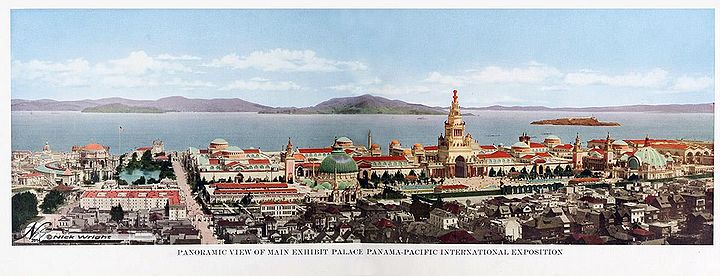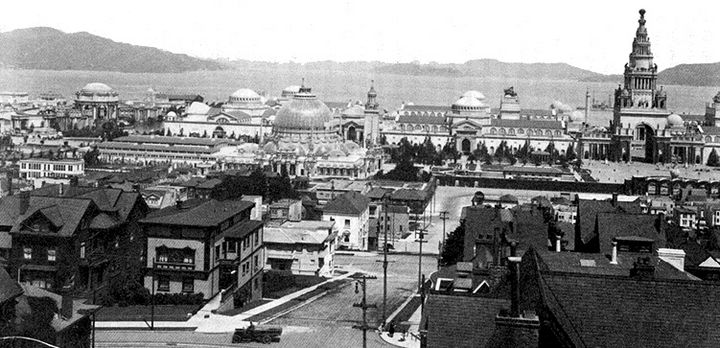SAILING TO BYZANTIUM: 1915 Panama Pacific International Exposition: Difference between revisions
(added new video) |
No edit summary |
||
| Line 2: | Line 2: | ||
''by Gray Brechin, from "Sailing to Byzantium: The Architecture of the Fair" in ''The Anthroplogy of World's Fairs'', edited by Burton Benedict'' | ''by Gray Brechin, from "Sailing to Byzantium: The Architecture of the Fair" in ''The Anthroplogy of World's Fairs'', edited by Burton Benedict'' | ||
[[Image:Ppie panorama hand colored 10580774 1472256113031678 111363553386763670 o.jpg|720px|thumb]] | |||
'''Hand-colored panorama of the Panama-Pacific International Exposition.''' | |||
[[Image:PPIE-artist-map-22in-wide.jpg|720px|thumb]] | [[Image:PPIE-artist-map-22in-wide.jpg|720px|thumb]] | ||
Revision as of 21:31, 4 September 2014
Historical Essay
by Gray Brechin, from "Sailing to Byzantium: The Architecture of the Fair" in The Anthroplogy of World's Fairs, edited by Burton Benedict
Hand-colored panorama of the Panama-Pacific International Exposition.
Artist's map of the 1915 Panama-Pacific International Exposition.
<iframe src="https://archive.org/embed/ssfPPIE1915" width="640" height="480" frameborder="0" webkitallowfullscreen="true" mozallowfullscreen="true" allowfullscreen></iframe>
Video: Prelinger Archive
| While the 1915 Panama Pacific International Exposition was held to celebrate the completion of the Panama Canal in 1913, it was also seen by city planners and dwellers as a stage to show off the city's - albeit hasty - resurgence and recovery following the earthquake and great fire of 1906. Today's only remaining specimen of the exhibit is the Palace of Fine Arts, however, the exposition left its stamp on the city, through its innovative architecture and city planning, yielding civic projects and developments that remain visible today, for example in the design of present day Civic Center with its Civic Auditorium and the contemporaneous structure of the emerging City Hall. |
At one point on the western edge of North America, the long wall of the Coast Range funnels inward to a precipitous cleft. A passenger on a steamship in the summer of 1915 entering The Narrows would have beheld an enchanted spectacle, for ranges of golden hills, like the wings of a vast stage set, opened around the bay and receded into the California hinterland. Just ahead and to starboard, an iridescent walled city rose from the water, an orderly array of domes and minarets backed by a long ridge of closely-packed mansions. Had it been twilight, a colossal tower rising from the center of the city would have been enveloped in an ambient film of light, the ancient walls would have been lambent with color and moving auroras would have filled the sky overhead.
This was what San Francisco wanted to be, but could only sustain for nine months. It was an evocation of a past that never was. It was the Panama Pacific International Exposition.
Panorama of the 1915 Panama Pacific International Exposition; Palace of Fine Arts (still standing) is on the left; the tall structure on the right is the Tower of Jewels.
Writing to a friend in 1915, young Edmund Wilson expressed the enthusiasm that millions of visitors felt for the fantasy city: "I probably shall not be able to convince you of how good the Exposition is. It ... is architecturally so successful that it at once raises the question why, if American architects can build temporary buildings as good as this, can't they build permanent ones of the same kind."1 Having noted that "A Western city makes Trenton look like Athens , Wilson went on to predict that "A great lesson should be learned from this Exposition! I look forward to the regeneration of America by means of architecture."
Ostensibly a celebration of the Panama Canal's completion, the Panama Pacific International Exposition was, in reality, a festival of self-congratulation and advertisement for the city that had so rapidly risen from the ashes of 1906. By 1915, few vestiges of the calamity were left, except for the raw newness of the area east of Van Ness Avenue. But regret attended the celebration as well; San Francisco, it was widely observed, was not the same city. "San Francisco," observed a visiting Eastern architect in 1912, "is a better city undoubtedly than it was in 1905, but it is hardly sufficiently better to compensate its citizens and its visitors for what has been lost."2 With the self-satisfaction attending a heroic rebuilding came remorse that such a splendid opportunity to realize the 1905 Burnham Plan had been missed. That plan, commissioned of the eminent Chicago architect and planner Daniel Burnham by civic-minded business leaders, envisioned a hilly Paris by the Golden Gate. Its idealistic megalomania and the massive disruption of existing land-use patterns that it would have required insured its doom in the rush to rebuild the city. Certainly by 1909 downtown was more cohesive and cleaner, with the predominantly cream-glazed terra cotta facades that newly lined Grant, Post and Kearny Streets a refreshing antidote to late-Victorian visual chaos. But the great ceremonial gestures--the boulevards, esplanades, park chains, and civic center that Burnham proposed-were missing. "Its citizens like to talk about it as the Paris of America," noted the same architect. "But French restaurants, electric lights, and a prevailing atmosphere of gaiety do not make a Paris. A metropolitan city must be tied together by a plan which provides for every essential economic and aesthetic need; and San Francisco still remains devoid of such a plan."3
The first plans for the Panama Pacific International Exposition seem an atonement for the haste with which the inner city was rebuilt; they sought to convert the entire city into an exposition with permanent improvements. Concentrated nodes in Golden Gate Park, Lincoln Park and Harbor View, on Telegraph Hill and along the waterfront would have been connected by splendidly lit and planted boulevards, including Market Street and Van Ness Avenue, which would have converged at a new Civic Center. A permanent tower, eight hundred fifty feet high, would have been built on the heights of Lincoln Park to commemorate the "heroic pioneers " and to serve as an immense lighthouse at the Golden Gate.
At the same time, local architect Ernest Coxhead proposed staging the fair along a beautified waterfront. Instead of concocting the usual plaster city, divorced from urban realities, Coxhead's novel proposal would have deliberately exhibited the activities that made San Francisco one of the world's foremost ports, while leaving behind enduring improvements. More candid than most of San Francisco's civic leaders, he stated the underlying purpose of any exposition for the host city: "What we want to do is to interest the world in our resources, we want them to stay here, invest their money here, and help us to develop the untouched, unparalleled resources that lie at our hands. . . ."4
Yet another architect suggested that the Mission and French Renaissance styles be rejected for a common Gothic theme, for the genius of our civilization is emphatically Anglo-Saxon," and "wherever the Anglo-Saxon and Spanish civilizations have come in contact the irrepressible conflict between them has flared forth in war." With a final flourish of Social Darwinism, he exclaimed, "How grandly it would grace this farthest western frontier of the civilization of the Anglo-Saxon, where it faces its anti-type, the oriental!"5
Early in 1912, the grandiose plans to hold a multi-nodal, citywide fair were scrapped because of the enormous cost involved. The site was narrowed to 635 acres at Harbor View and in the adjacent Presidio. The State undertook a nine-million-dollar improvement of the waterfront that resulted in the wall of classical and Mission revival bulkheads that stand along the Embarcadero. Under the new mayor, James Rolph, Jr. (also vice-president of the Exposition Company), plans for a new Civic Center were prepared and the Exposition (now Civic) Auditorium rushed to completion, while the competition-winning City Hall was begun.
Site planning for the fair began immediately and quickly resulted in four innovations that distinguished the Panama Pacific International Exposition from previous expositions and which were symptomatic of a degree of planning coordination rare not only for expositions in general, but for San Francisco in particular.
<iframe width="420" height="315" src="//www.youtube.com/embed/9t_PyZpbfFU?rel=0" frameborder="0" allowfullscreen></iframe>
The historical silent film footage was found in 1961 in Tiburon and Ray Hubbard wrote and produced it for KPIX TV with help from Lee Mendelson . R.E. Pusey edited, Walter Johnson narrated it for broadcast. This digitized copy sourced through the San Francisco Bay Area Television Archive, via Youtube.



